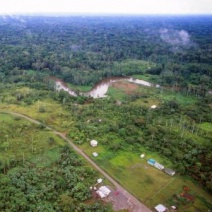Applying The Water-Energy-Food Nexus In The Amazon
Deforestation in the Amazon has a ripple effect through the region disrupting ecosystem services and undermining food, water and energy security. The Global Canopy Programme says coherency among policy-making can help, and in a new policy brief outlines how some Amazon countries would benefit from following the integrated approaches of the water-energy-food nexus.

12 September 2016 | Brazil, Colombia and Peru share over 80% of Amazonia and combined have lost an estimated 3 million hectares of forest per year between 2001 and 2014, largely as a result of agricultural and infrastructure expansion. It is increasingly recognized that the loss of tropical forests and their key ecosystem services will undermine the region’s long-term economic prosperity and capacity to maintain water, energy and food security.
In addressing environmental degradation, climate change and its associated risks, Brazil, Colombia and Peru have taken important steps towards low-carbon development pathways, with a strong emphasis on forest preservation. For example, Colombia and Peru have pledged to achieve zero net deforestation by 2020 and 2021 respectively, and Brazil to end illegal deforestation by 2030.
Yet, Brazil, Colombia and Peru, among other countries in Amazonia, face a difficult challenge in balancing conservation and climate objectives while pursuing development agendas and meeting growing demands for food, water, and energy.
It is increasingly understood that reconciling these objectives and realizing sustainability commitments, (e.g. the Sustainable Development Goals; the Paris Climate Agreement) will require more holistic and coordinated policy approaches.
In this context, the water-energy-food (WEF) nexus has emerged as an important conceptual framework to improve natural resource governance. By accounting for interdependencies between water, energy and food systems, such an approach can support decision makers in evaluating resource trade-offs across different economic sectors and actors.
Applying the nexus approach in Amazonia
In applying the WEF nexus framework in Amazonia, as part of a policy coherence analysis for Brazil, Colombia and Peru, the importance of this approach for identifying key policy gaps and conflicts – in particular around competing demands on water and land resource – is further highlighted.
The analysis shows how the envisaged expansion of planted forests, soy, sugar cane and palm oil production to meet both domestic renewable energy targets and export demands has clear contradictions with climate objectives, given their historic and ongoing expansion in Amazonia. This is evidenced most recently in Peru where 72% of the current oil palm production has occurred at the expense of forest ecosystems. More broadly studies also point to complex links between biodiesel production and indirect land use change in Amazonia as a result of the displacement of other crops/pasture into forestland. Similarly, the expansion of monoculture systems such as soy and sugar cane can be detrimental if it competes for water and land, drives up market prices, or displaces other crop varieties and subsistence farming systems that can contribute more directly to local food security and climate resilience. This is particularly relevant in Brazil where increases of 700,000 ha for sugar cane and 22 million ha for soy by 2023/2024 are envisaged under current policy objectives.
Because both biofuel and food crops are predominately grown under rain fed conditions and therefore depend on renewable water sources in the Amazon basin, ongoing forest loss and climate change pose considerable food and energy security risks. The reduced water volumes and sedimentation associated with land use change can further impact energy security linked to hydropower generation, which currently forms the backbone of electricity sources in Colombia, 64%, and Peru, 53%, and is set to expand to almost 86% in Brazil by 2024.
While these examples highlight the implications of current policy formulations in achieving water, energy and food security and broader sustainable development commitments in the region, the exercise also reveals particular limitations with this kind of assessment.
Limitations to this approach
Namely these centre around insufficient data/information and the lack of existing studies that capture the diversity of resource use dynamics across sectors. The complexity of WEF systems means that the interdependencies are not easily disentangled without a clear evidence base to develop from. These constraints subsequently mean that much of our understanding on the interdependence between forest ecosystems and WEF security is largely superficial.
While general observations of WEF trade-offs have a role in spurring further questions and revisions in policy, they stop short of the detail needed to truly pinpoint actions and policy interventions.
Furthermore, given the changes in the economic, political and environmental landscapes of Amazonia over time, is also important to recognize the temporality of any coherence and WEF nexus assessment; pointing to the need to undertake ongoing WEF nexus analyses to account for new and changing variables.
Moving the WEF nexus approach forward
Accessible decision support tools that can help stakeholders to build future scenarios, identify policy responses, and quantify the resulting economic, environmental and social trade-offs across different actors are needed to help identify ‘quick wins’ and ‘low regret’ options for optimizing water, energy and food security.
Integrating the nexus approach in decision-making and governance instruments in Brazil, Colombia and Peru will require building a coherent WEF understanding and awareness across a coalition of public-private sector and local actors that govern water, food and energy resources.
This needs to be accompanied by a solid evidence base on the role of Amazonia and its sub-basins in underpinning WEF security that can inform landscape-specific assessments to allow different actors to formulate adequate policy. Analysing the distribution of risks, costs and opportunities across multiple stakeholders will also be critical in developing incentives to encourage aligned action around WEF objectives.
Such considerations will be vital in mobilizing the resources and efforts required to integrated WEF thinking as part of a wider repertoire of approaches to strengthen institutions and policy frameworks to better manage natural resources and support a WEF security agenda in Amazonia.
Please see our Reprint Guidelines for details on republishing our articles.

